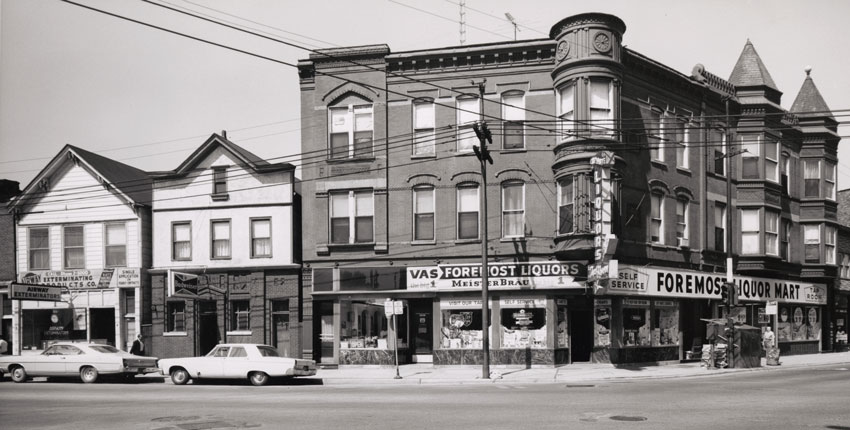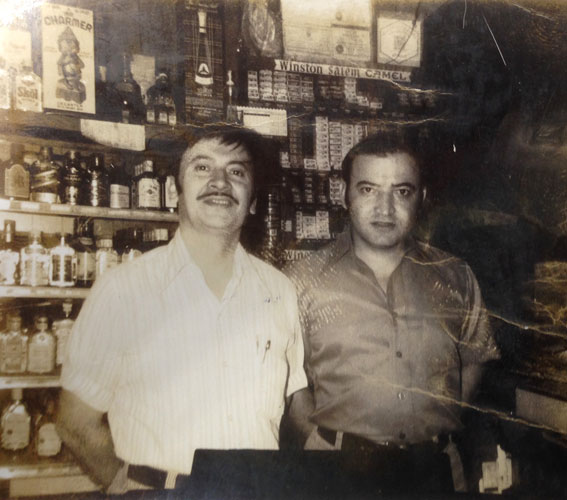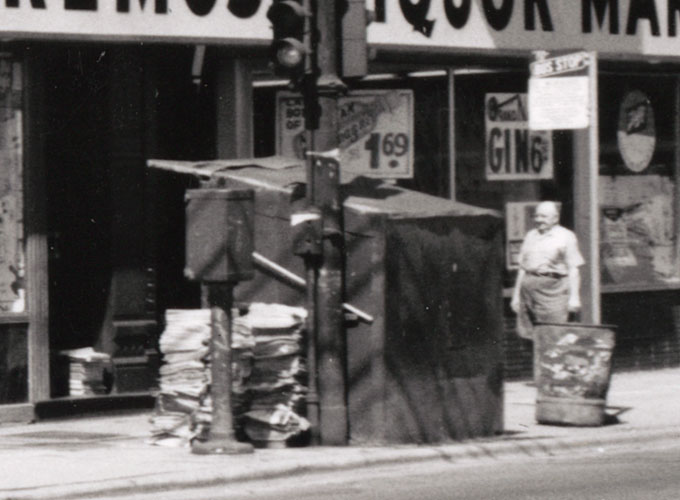
Businesses on the southwest corner of California and Milwaukee Avenues, photographed in June 1970. Chicago History Museum, ICHi-176694; Sigmund J. Osty, photographer
The Corner Six Decades Later
A 1970 photo from the Chicago History Museum provides nearly the same vantage point as the 1908 postcard image. The same storefront buildings are recognizable although they have been stripped of their woodwork around the windows and covered with new siding.
Most prominent in the photo is the turreted apartment building on the corner, which still stands, though it too has lost some of its ornamental detail and sadly no longer sports a grand neon sign. Vas Foremost Liquors is still operating in the building today. Spyros Vaselopulos and his brothers started out running a tap room and package goods liquor store here in 1957. The tap room originally occupied just the corner storefront. The liquor for sale was displayed on tall shelves behind the bar, requiring a step ladder for the bartender to retrieve the highest bottles.
The corner building is actually two separate structures sharing a common center wall, which is visible above the "M" in the Foremost sign on the right side of the photo. Hugo Otto bought the left-side property in 1888 and hired architects Thiel & Lang to design a $10,000 brick and stone building for the corner which was constructed by builder Chris Nissen in early 1889. Otto acquired the two neighboring lots the next year and the adjoining building was erected in 1892. There are ten apartments on the second and third floors of the connected buildings.
Bill Vaselopulos says that in the 50s-60s the tap room on the corner was open from 7 am to 2 am weekdays, and an hour later on Saturday nights. On Sundays the regulars would line up to wait for opening at noon and would get a free second beer for sticking around. Many regular customers became friends. Sometimes they even took vacations together. After closing time, the party would often head over in the 24-hr Terminal Restaurant below the Logan Square L station for late-night sustenance.

Spyros & Bill Vaselopulos in the old tap room. Courtesy Pete Vaselopulos.
In 1965, the Rickles dime store in the western building (right side of photo) closed down. The Vaselopulos brothers purchased the building and expanded their store into this space. The new store joined the Foremost Liquors chain and opened as only the second "self-service" liquor store in the area, with open shelves for customers to pick out their purchases themselves.
In 1997 the store remodeled and removed the old tap room bar, along with the storefront to its left in the photo above which housed a small barber shop. These areas were made into a combined retail space which is now occupied by a Subway sandwich shop.
The former Daly saloon from 1908 at 2234 N. California was still operating as a tavern in the 1970s, and still serving Budweiser beer. In the photo above there is a beer sign hanging over the door, but no obvious name of the establishment. The Pioneer Club run by Margaret Murphy was a private club. Patrons needed to be invited by members and buzzed in to enter. You may be shocked (shocked!) that there was gambling going on behind the closed doors.
The little building at 2232 on the left in the photo, which once housed the St. Paul Restaurant, remained a cafe at least until the 1940s, then became a small grocery. In about 1960, Airway Exterminators moved here from a storefront across the street, where the Cozy Corner side dining room now stands.
Though the streets in 1970 hosted less sidewalk commercial activity than in the 1908 photo, there is a small outdoor newsstand near the front door to the liquor mart. The wooden awning is up. Stacks of freshly-delivered papers lean against the wall.

Detail of newsstand from photo at top
In 1970 Chicago still had four daily papers: the Tribune and Sun-Times as well as the afternoon papers Chicago Today (owned by the Tribune) and the Daily News, home of the celebrated columnist Mike Royko. Delivery drivers dropped off papers throughout the day, so that commuters returning from the L might read the most updated news stories. By the end of the 1970s both of the afternoon papers had ceased publishing after losing readers to the even more up-to-date format of television broadcast news.
Bill Vaselopulos remembers one of the news sellers was a man named Oscar, a Canadian veteran of the Gallipoli campaign in World War I. The small newsstand had a heater inside but it must have been quite chilly on winter days when when the tall corner building blocks the midday and afternoon sun.
